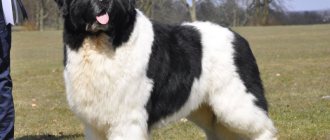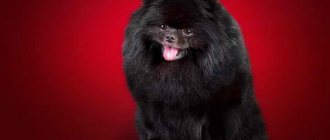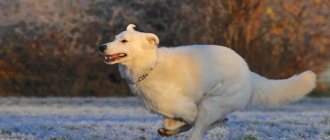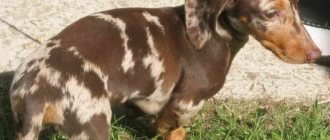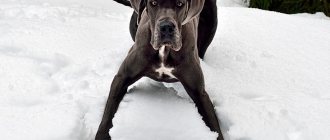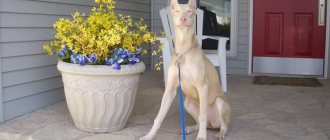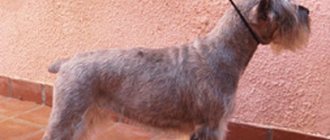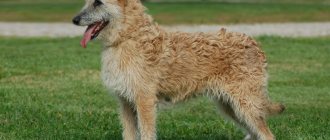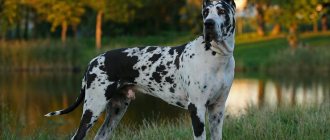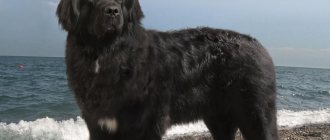Shar Pei is both a very ancient and very young breed. These dogs lived in China for centuries and millennia, helping peasants and sailors in their difficult work.
But as a breed, these dogs were recognized about forty years ago, and their first standard appeared in 1976. And if in the 70s and 80s of the 20th century they were so rare that they were even included in the Guinness Book of Records, but now these dogs have long enjoyed well-deserved popularity all over the world.
Breed standard and characteristics
This is a harmoniously built dog of medium height, with a strong and muscular body of almost square format. Royal, majestic, noble and even arrogant. The Shar Pei is intelligent and quick-witted, affectionate and playful. At first glance, this dog seems slow and inert, but in reality it may even be too active. A good watchman who doesn’t need to be taught how to guard: it’s in his blood.
Important! Distrustful of strangers, sometimes aggressive towards them, but invariably affectionate and affectionate towards his owner.
Excerpts from the FCI standard
An original Chinese breed that lived for centuries and millennia on the shores of the South China Sea and was bred in the Kwong Tun province.
A strongly built, square-shaped dog with heavy bones, but at the same time active and agile.
A wide and flat skull, rather large in relation to the body, the transition from the forehead to the muzzle is slightly pronounced. There are drooping folds on the forehead and cheeks, “flowing” down and forming a dewlap under the lower jaw and on the neck. The muzzle is similar to the mouth of a hippopotamus, wide and thick, approximately equal in length to the skull.
The nose is wide and large, preferably black. Animals with a weakened color (diluted Shar-Pei) have a coat color that matches: graphite gray in blue, brown in chocolate and beige or reddish-brick in color in red, as well as apricot and cream.
Almond-shaped, deep-set, small and preferably dark eyes .
Wide and strong jaws. The bite is scissor-shaped, the teeth are straight and white, the canines are slightly curved, which contributes to a more tenacious grip of the dog.
The tongue, palate, and gums are blueberry or lavender in color.
The ears are quite dense and small, similar in shape to an equilateral triangle. Their ends bend slightly upward and are located above the eyes.
The neck is strong and strong with thick skin that hangs down like a dewlap.
The chest is deep and wide, the back is short, slightly arched, descending first to the withers, then rising to the croup.
The hind legs are straight, strong and muscular, with low hocks. Their spacing is quite wide.
The paws are medium in size, high and convex, with splayed toes, reminiscent of a head of garlic in shape.
The tail is round and thick at the base and gradually tapers towards the tip. In horse dogs it is smooth and seems thin, in brush dogs it is covered with thick and rather long hair so that in some individuals it resembles a plume.
Three types of tail position are allowed. They are listed below in order of preference:
- The tail is in a tight ring; in some dogs it is shaped like an old Chinese coin.
- Tail in a loose ring.
- The tail is thrown over the back, but the tip does not touch it.
THIS IS INTERESTING! There are dogs of this breed whose tail forms not even a single, but a double curl.
Dog character
Behind the sullen and gloomy appearance of the Shar Pei lies friendliness, love, kindness, cheerfulness, and curiosity. In addition, the dog has the qualities of a real psychologist.
The character of the Shar Pei has a desire to be a leader, so the owner of such a dog must have a strong and strong-willed character. It is worth noting that already a four-month-old puppy is well versed in the hierarchical structure of the family where he lives.
He will not obey the children, but at the same time he will not offend them. However, the dog should be taught to communicate with children. Dogs ignore individual family members for the rest of their lives.
The animal's aggressiveness increases significantly if you grab it by the legs or suddenly put your hand on it. This is due to the characteristics of peripheral vision, since due to large eyelids it is very weak.
Animals are highly intelligent. If they find themselves in an extraordinary situation, they will not lose their composure. Being alone in a living space while waiting for a long time for the owner will not damage things and clothes. Shar-Peis living outside the city will not run through flower beds and beds, but will walk along well-trodden paths.
The dog completely adapts its regime to the owner’s daily routine:
- the owner lies down to rest or sits down to work, at this time the Shar Pei will take a nap or lie down on its bedding;
- if the pet sees a leash in the owner’s hands, he rejoices and hurries to go for a walk;
- the dog's morning rise time coincides with the owner's routine;
- if suddenly the owner is overcome by sadness, the dog will grieve with him.
The Chinese Shar Pei tolerates trips and travel well. Although traveling with a dog is a troublesome task, neglecting your pet and not wanting to take it with you will negatively affect its character.
Weight
The weight of these animals ranges from 18 to 25 cm, according to the standard. But in reality it can be much larger, first of all this applies to large and powerful males: Shar Pei weighing 35 kg or more are not uncommon among them .
IMPORTANT! The dog's weight should correspond to its height. A dog can be neither light nor too heavy.
How long do Shar Peis live?
The average lifespan of a purebred Shar Pei is 10 years.
The life expectancy of a Shar Pei living at home is influenced by the following factors:
- Heredity.
- Dimensions. The larger the animal, the more energy the body expends to maintain its vital functions.
- Compliance by owners with the rules of keeping a dog.
- Regularity of sexual activity and number of births for females.
Muzzle
The standard says that in the Shar Pei it is thick and large, reminiscent of the mouth of a hippopotamus. And this is the most accurate description of the “face” of any of the representatives of this breed.
The Shar Pei's muzzle should be massive and wide, not tapering towards the nose. These dogs have heavy and drooping lips, with the upper one being especially large, thick and voluminous.
Nutrition
The lion's share of breeders of this breed believes that the optimal feeding regimen for Shar Pei is twice a day. Therefore, when choosing a diet for a four-legged friend and when creating a menu, owners should remember that it is better to give preference to dietary products. The dog is prone to obesity and easily gains excess weight. The prevention of obesity is the most effective physical activity.
In some countries, the Shar Pei's blue tongue is believed to ward off evil spirits.
By the way, the dog itself is quite selective and picky about food. Therefore, more than one week may pass before her taste preferences and the owner’s finances coincide. An adult Shar Pei should receive a sufficient amount of fresh meat.
At least 35% of the diet consists of fruits and vegetables, the same amount - cereals and meat products. The remaining percentage comes from dairy products, which includes everything except the milk itself. It is forbidden to feed a Shar Pei with butter, sweets, give it salty, fatty and smoked foods, avoid caviar and sausage, as well as pearl barley and wheat groats.
Coat type
The standard specifies two types of wool; in fact, there are many more. Many of these types are transitional between Horse and Brush and differ from them in a slightly softer or coarser coat .
For example, a type of coat that does not have official recognition, but is widespread among Shar-Peis, which some breeders call velor, is the same horse in length, only softer to the touch . Among all types of wool, the so-called bear wool stands out - also soft, like velor, but at the same time exceeding the length of brush .
ATTENTION! The Shar Pei's coat should be hard and thick. It rises slightly above the surface of the dog’s skin on the body and neck, but on the head, ears and limbs it should be shorter and fit tightly to the skin. The coat of dogs of this breed is healthy in appearance and thick, but does not have shine or, let alone, gloss.
Horse
Very short and stiff hair, similar to horse hair, is called horsecoat. This coat has a stubble-like feel and is more likely than any other to cause contact dermatitis when touched.
Important! The length of the horse's coat should not exceed 1 cm.
Brush
Brushcoat, or bristly coat, the length of which should not exceed 2.5 cm at the withers. The guard hair is softer than that of the Horse, but very elastic and thick.
Bear
Very long and soft, plush coat, noticeably different from standard horse, brush and even all transitional types, including velor.
In appearance, a Shar Pei with such fur looks more like a Chow Chow than a representative of its breed, and bear puppies, especially those of light color, are adorable.
Nevertheless, the interesting and in its own way attractive bear type of fur is outside the standard and is considered a breeding defect .
Puppy cost
There are several types of pets depending on their cost in rubles:
| Class name | Peculiarity | Price in rub. |
| Mongrel | No documents, hand-held puppy, sick animal, mixed breed | 5-10 thousand |
| Pat | Minor deviations from the standard, healthy individuals. They are not allowed for breeding or exhibitions. | 11-14 thousand |
| Brit | Documents are in order, clean dog, but not competitive | 20-35 thousand |
| Show | Animal for exhibitions | More than 35 thousand |
Color
Shar Pei coat colors are divided into two types: basic and diluted .
The main colors containing black pigment with varying intensities include:
- black;
- red;
- red deer;
- cream;
- blue;
- isabella;
- sable
Dilute colors in which the black gene is replaced by brown, also called weakened:
- chocolate dilut;
- red dilut;
- apricot dilute;
- cream dilut;
- purple dilut;
- isabella dilute;
- sable dilut.
THIS IS INTERESTING! Sometimes mahogany and mahogany dilute, as well as platinum dilute, are added to this list. But the first two of them are the same basic red and red dilut, only brighter and more saturated. As for “platinum”, according to the standard it refers to cream and cream-dilut, although debate about whether it should be made into a separate color has not subsided to this day.
Origin story
Historians of the breed agree that the birthplace of the Shar Pei is China. However, the exact place of origin is unknown - either the territory of the South China Sea, or Tibet. In any case, the Chinese Shar Pei in its homeland has always been used as a guard and hunting dog.
For many centuries, the Shar Pei remained the title of one of the most popular and necessary animals in the household - pets did an excellent job of protecting livestock, homes and even children. However, in the middle of the 18th century, the status of these cute dogs could change - they became interested in dog fighting fans, who decided to release persistent and brave dogs into the ring. Despite suitable external characteristics, sharpeis showed poor results in battle, and therefore completely lost their importance as fighting dogs, unlike their European counterparts - bulldogs and pit bull terriers.
The Shar Pei population was even more damaged when the Chinese Communist Party came to power in 1921. In a series of decrees, the Communist Party of the Communist Party prohibited having pets on the household, as it considered them a waste of food resources. As a result of such a policy, by the end of the 60s. The number of Shar Peis in the country was miniscule.
Several specimens of this breed remained in Hong Kong, where Matgo Low took up the task of reviving the species, and voiced to the international public the problem of the disappearance of the Shar Pei breed. Breeders from all over the world responded to his call for help, and modern representatives of the species found their second home in the USA. Thanks to Matgo Low and American breeders, Shar Peis remain one of the symbols of China today.
Related article: What is tasty and healthy to feed your Shar Pei at home?
Tongue color
In a Shar-Pei of the main color, the tongue can be exclusively blue-black; for a dog of dilute color, a lighter, lavender shade is acceptable. The color of the tongue is already visible in small puppies, although many of them are born with a lack of pigmentation. An adult dog's tongue should be spotless and one solid color.
Important! A pink tongue in a dog of this breed is considered a disqualifying fault.
Shar Pei is a dog whose character and appearance have been developed over centuries through the painstaking work of breeders. This dog has a number of specific characteristics that distinguish it from other breeds and make it unlike any other dog. All the features inherent in the Shar Pei were reflected in the standard of this amazing breed.
What should a Shar Pei menu be like?
As with feeding any pets, there is a choice of using dry food for feeding or preparing the food yourself.
Both methods have their advantages and disadvantages. Ready-made food should be premium, with a price tag that weighs enough for the owner’s wallet.
Cooking your own food takes personal time and requires purchasing high quality products.
Therefore, an assessment of financial capabilities is prevalent when deciding to adopt a Shar Pei dog into the family.
The dog does not have a good appetite. Long walks and games in the fresh air will help improve your appetite. The dog needs to be fed twice a day.
The diet must include:
- meat and offal. The main part of the diet, any raw meat is suitable, except pork, chicken and raw liver. The last two products can cause severe allergic reactions;
- fish. Served two to three times a week boiled or stewed. The fish should not be fatty and marine. It is important to remove all the bones from a fish dish before serving.
- milk and dairy products. Only puppies can lap up milk. For an adult dog, kefir, yogurt, and low-fat varieties of cottage cheese are suitable.
- quail eggs. They are given several times a week, two pieces raw, along with the shells.
- cereals The diet will be supplemented with boiled buckwheat, rice, and oatmeal; if the dog is obese, the best option for feeding him would be pearl barley.
An excellent addition to the diet will be vegetables: carrots, pumpkin, zucchini, broccoli.
Basic rules of care
Coat care consists of infrequent brushing using a special brush for dogs with short hair or a special mitten.
Shar Peis are bathed only when necessary, as stagnant water in their folds can lead to skin diseases..
The eyes and ears of blue Shar-Peis need to be examined regularly and cleaned if necessary.
Claws usually wear down while walking on asphalt or other hard surfaces . But sometimes they still have to be shortened using nail clippers.
IMPORTANT!
The teeth of young dogs fed solid food usually do not require special care.
Older Shar-Peis can be brushed using a special paste for dogs.
How to choose?
You need to buy such a puppy only with documents that not only guarantee the purebred origin of the baby, but also, to one degree or another, will be the key to his health.
After all, professional breeders are interested in ensuring that the dogs they breed are not only beautiful and receive first places at shows, but also that they do not have hereditary diseases.
CAREFULLY!
When choosing a pet, you need to pay attention to those puppies in the litter that are not very active, but at the same time are not too slow.
And, of course, the kids must be completely healthy. If they have already had their eyelids stitched, the stitches should be removed and the wounds should be completely healed.
If we talk about color characteristics, then it is better to buy a puppy with a coat of medium richness and lightness of a bluish color, which does not contain any admixture of brown or pinkish shades.
The cleaner and brighter the coat color in puppyhood, the greater the chance that it will remain that way.
